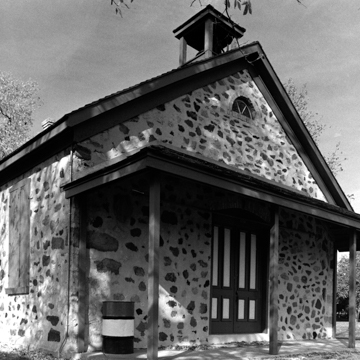In 1885, nineteen-year-old Bernard Cigrand held the first known observance of “Flag Birth Day” here, where he was a teacher. The school’s graduating class—mostly descendants of Luxemburger immigrants—honored Old Glory by reading essays they had written and discussing the flag’s history and meaning. Cigrand then launched a thirty-one-year campaign for an annual national observance of the flag’s birth. In 1916, President Woodrow Wilson proclaimed that on June 14, citizens would honor the national symbol. In the late 1940s, the National Fraternal Flag Day Foundation acquired and restored Stony Hill School as the organization’s shrine.
The simplicity of the schoolhouse gives it charm. Fieldstone rubble, set in a heavy mortar mixture, composes the walls of the single-story, one-room building. Atop the front-gabled roof rises a small wooden belfry with a school bell. Schoolchildren entered the building through paneled double doors, crowned by a segmental-arched brick lintel. A wooden porch spans the facade, and wooden shutters cover the windows. Over the years, the building lost its door, porch, and belfry (if that element ever existed). Between 1948 and 1952, the Flag Day Foundation renovated the school to resemble its historic appearance.


